Learn how to make kimchi at home with this spicy kimchi recipe, including ingredients swaps and variations so you can make it your own way. I make mine with an easy wet brine and lots of extra spices.
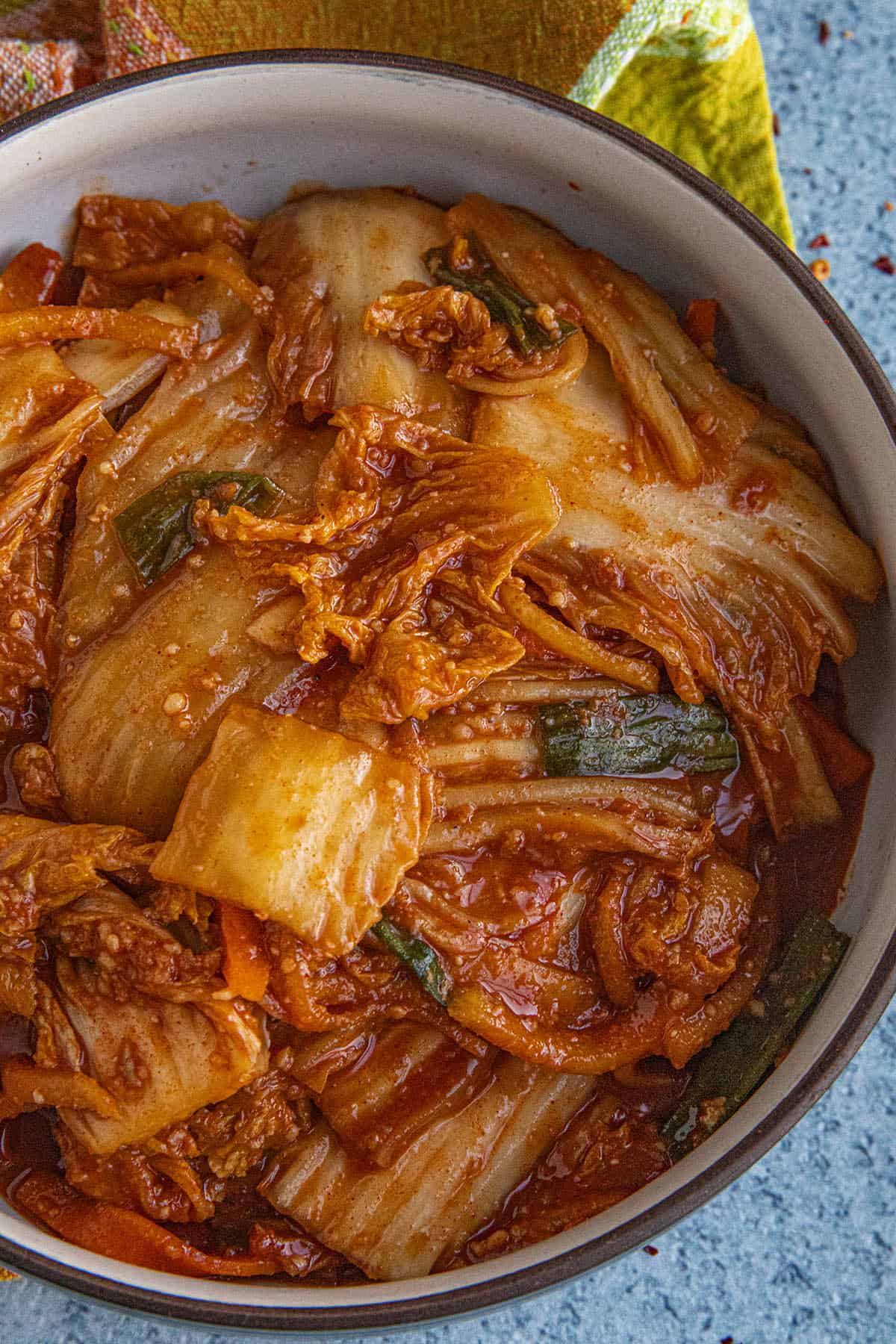
How to Make Kimchi (Kimchi Recipe)
We're making Homemade Kimchi in the Chili Pepper Madness kitchen today, my friends. If you're spicy food lover, I'm certain that kimchi is already on your radar.
Kimchi is a Korean dish of spicy fermented vegetables, and extremely significant to Korean cuisine. It is consumed in many ways throughout Korea, tossed into fried rice dishes, ramen type dishes, served up as the star of the meal or nibbled on as a simple, healthy snack.
Napa cabbage is more commonly used, though it can be made with many other vegetables. The process involves fermentation, which is the break down of foods by lactic acid bacteria in a salt brine.
The result is healthier, well preserved food with more vitamins and a characteristic funk factor.
This particular version is the more popular Baechu Kimchi, or Napa Cabbage Kimchi, and we love it. It's definitely a spicy kimchi, as I include some extra spice, as well as extra umami because we just love it that way.
I also use a wet brine method, as opposed to a dry brine method, because it is easier to do and more fool-proof. Some people prefer the dry brine method, which is totally fine, but I always get great results this way.
Let's talk about how to make kimchi, shall we?
Kimchi Ingredients Needed
- FOR THE CABBAGE BRINE
- Unchlorinated Water. For brining the cabbage. Filtered or bottled water are good.
- Salt. Kosher salt or sea salt.
- Napa Cabbage. Use 1 large head, about 3 pounds.
- TO MAKE THE KIMCHI
- Extra Vegetables and Fruit. Carrots, scallions or green onions, daikon radish or turnip, fresh garlic and ginger. Also, an Asian pear for sugar/sweet.
- Glutinous Rice Flour. This not only helps the spicy kimchi sauce stick to the cabbage and vegetables, but also provides some sugars for fermenting.
- Gochugaru. Gochugaru is a coarsely ground Korean chili powder, or red pepper flakes, that add lots of flavor and spice it up. It is best to use authentic gochugaru, not a substitute.
- Umami. I use fish sauce and salted shrimp (saeujeot) and miso paste. As an alternative, use shrimp paste, or chopped dried shrimp, soy sauce, or other umami ingredients. See the recipe notes below.
How to Make Kimchi - the Recipe Method
BRINE THE CABBAGE
Make the Brine. Whisk together the unchlorinated cold water and sprinkle salt in a large bowl.
Slice the Cabbage. Slice off the root end of the cabbage. Slice the cabbage into quarters and submerge them in the brine. Use a plate or other small weights to keep the cabbage completely submerged.
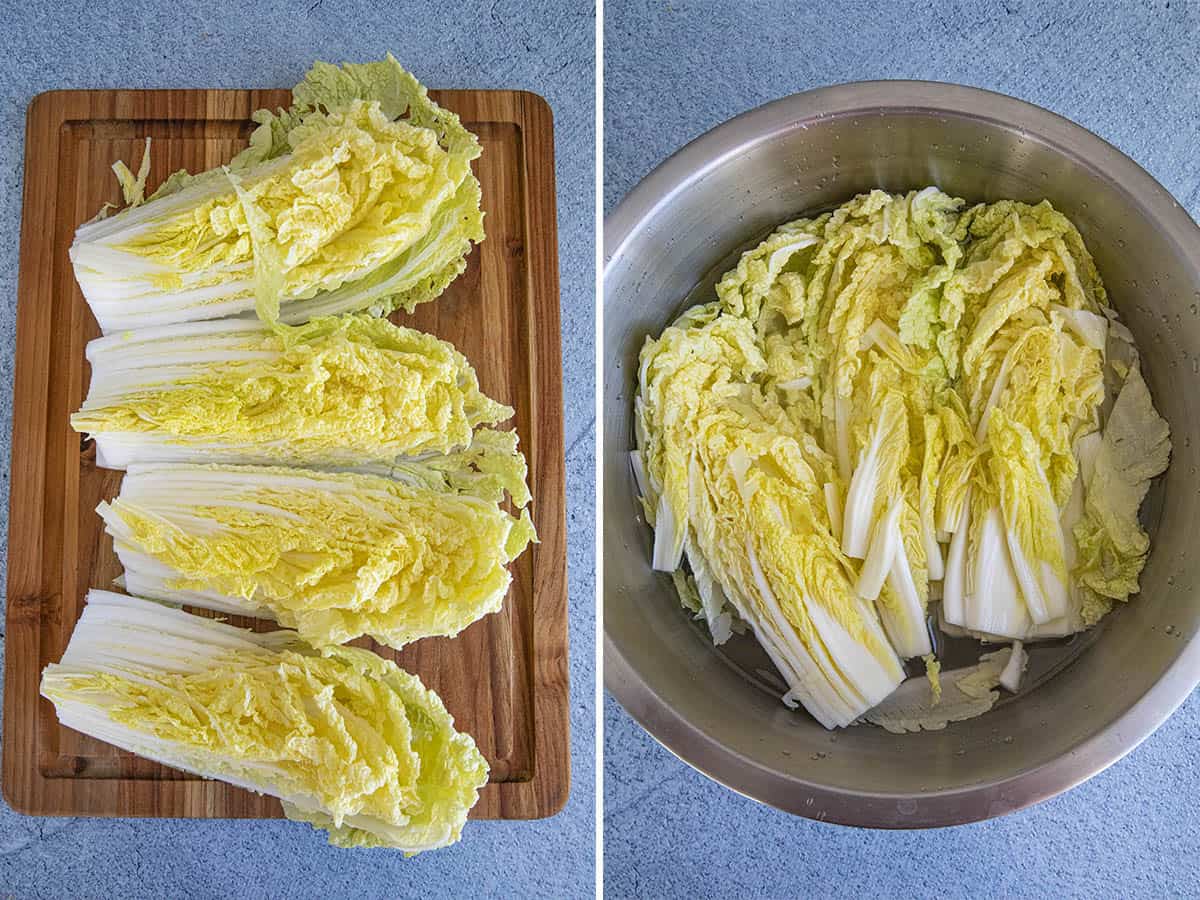
Brine the Cabbage. Set aside for 8-12 hours at room temperature.
Rinse and Chop the Cabbage. Set the cabbage into a colander and drain the brine. Rinse the cabbage and squeeze out excess water using your hands. Chop the cabbage into 1 inch pieces (if desired, or leave the pieces whole).
PREP THE VEGETABLES
Slice and Combine the Vegetables. Slice the the carrot, scallions, radish or turnip, and Asian pear into thin slices or matchsticks. Chop the garlic and ginger.
Add them all to a large bowl along with the chopped cabbage. Toss to combine.
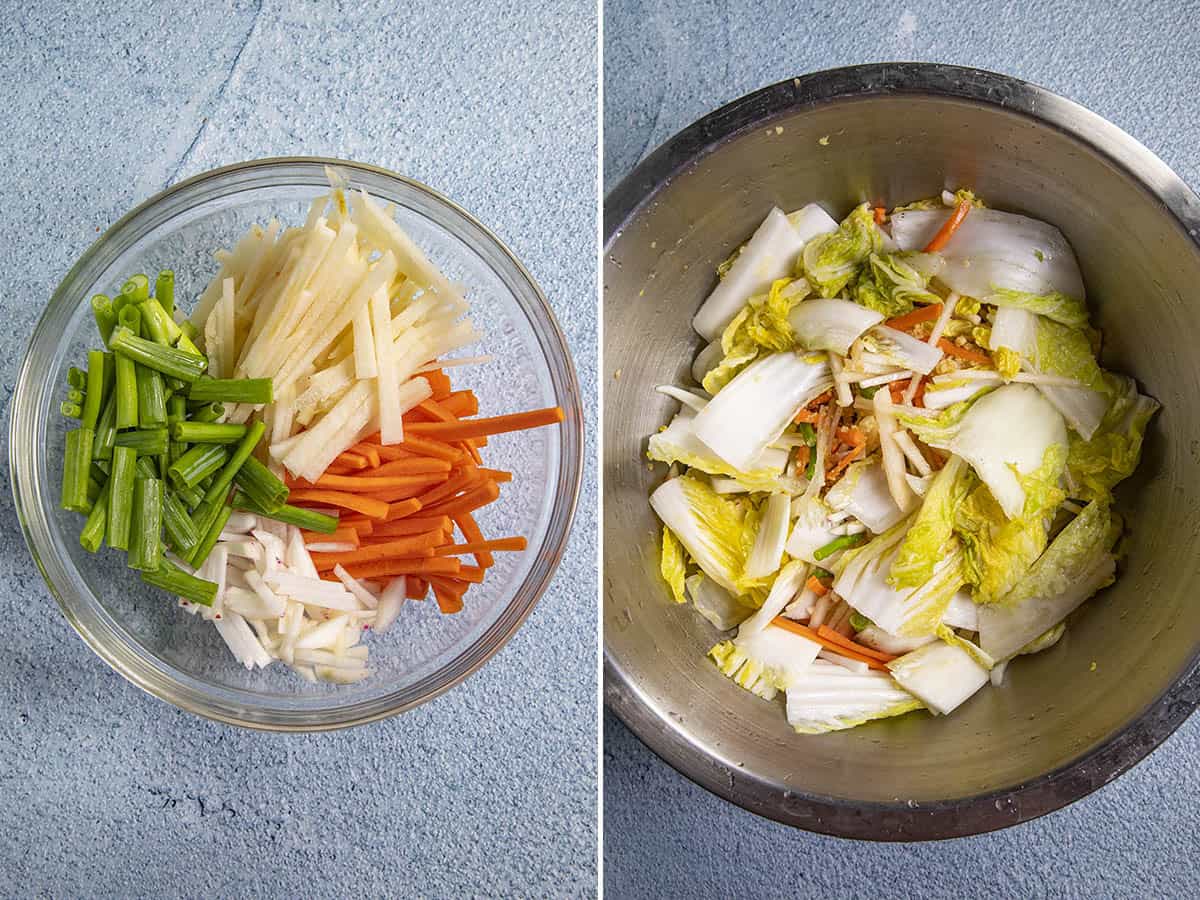
MAKE THE KIMCHI SAUCE
Glutinous Rice Flower. Add the rice flour and 1 cup water to a sauce pan. Heat to a simmer, then whisk for 3-4 minutes until smooth and the mixture forms a smooth, loose paste.
Korean Chili Flakes (Gochugaru). Remove from heat and stir in the gochugaru. The chili flakes will bloom as the mixture cools.

Add the Umami. Stir in the fish sauce, salted shrimp, and miso paste (or your other umami alternatives).
MAKE THE KIMCHI
Mix with the Cabbage and Vegetables. Pour the mixture into the cabbage leaves and vegetables. With your hands, rub the gochugaru mixture into the vegetables, covering them as completely as possible. Be thorough.
Really get in there with your hands!
Taste and Adjust. Taste and adjust for salt or any other desired seasonings. Need more chili flakes? More fish sauce? Go for it!
Pack into Jars. Pack it all into a large mason jar (or several). You can use other vessels, like a fermentation crock. Press the contents down and weigh it down with glass fermentation weights (or use a plastic bag filled with water).
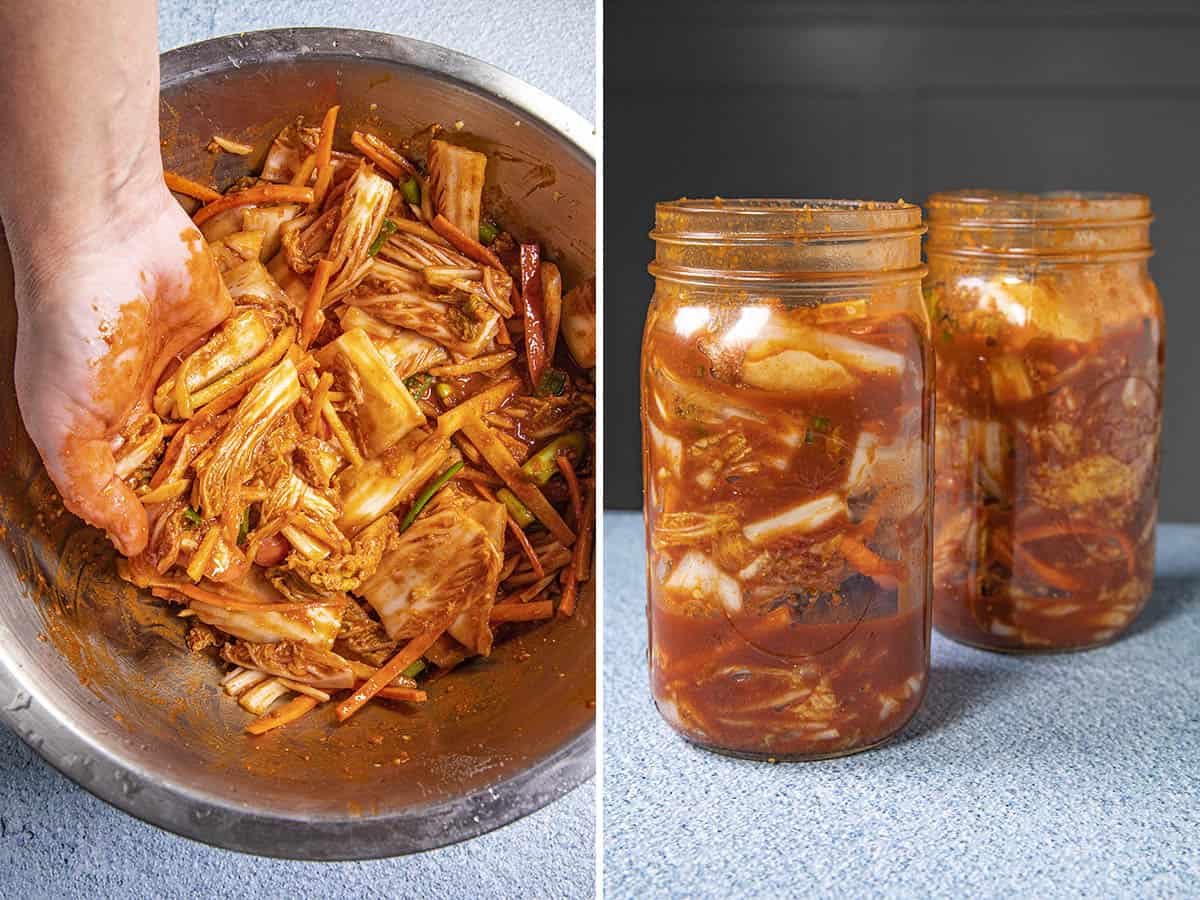
Cover for Fermentation. Cover with a fermentation airlock lid, or use fermentation membranes (see notes). If you don’t have such lid options, use a 2-piece lid, but don’t screw it down, just set it on top.
This is to allow any gases to escape while fermenting.
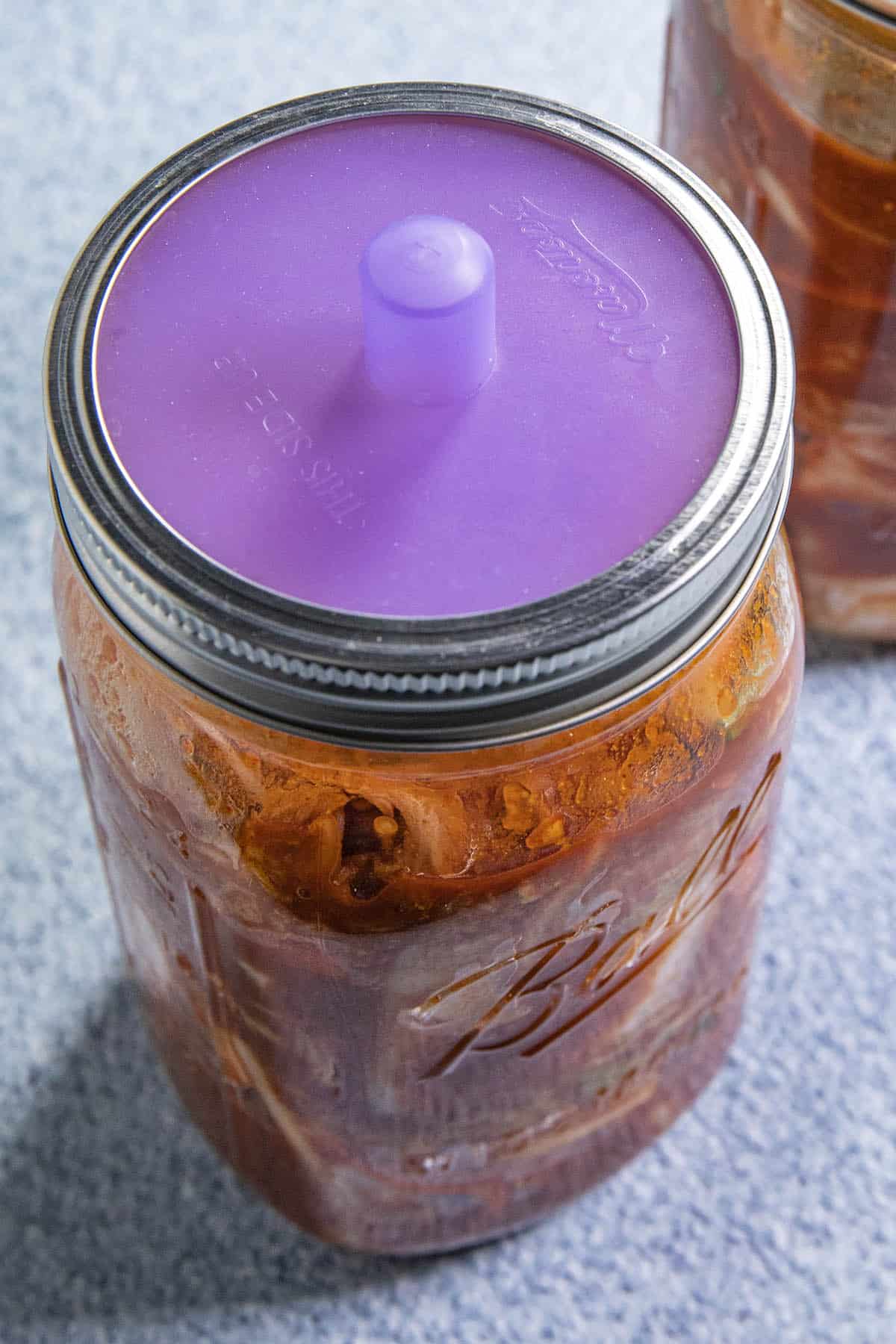
Ferment the Kimchi. Set aside away from any sunlit areas and ferment for 1-3 days at room temperature (you CAN ferment longer if you’d like – see RECIPE NOTES on fermentation times).
Moisture should release from the jar, so press the kimchi down if needed to keep it below the liquid. Gases should escape via the fermentation membrane, or just loosen the lid to let any gas build up out.
Refrigerate. Set into the refrigerator and let sit for 1 week to let the flavors mingle. You can enjoy it right away, but it is better to wait.
The fermenting kimchi will continue to ferment slowly in the fridge.
Boom! Done! Your kimchi is ready to go. Super curious how you plan to use your fermented cabbage once it's ready. And how spicy you made it!
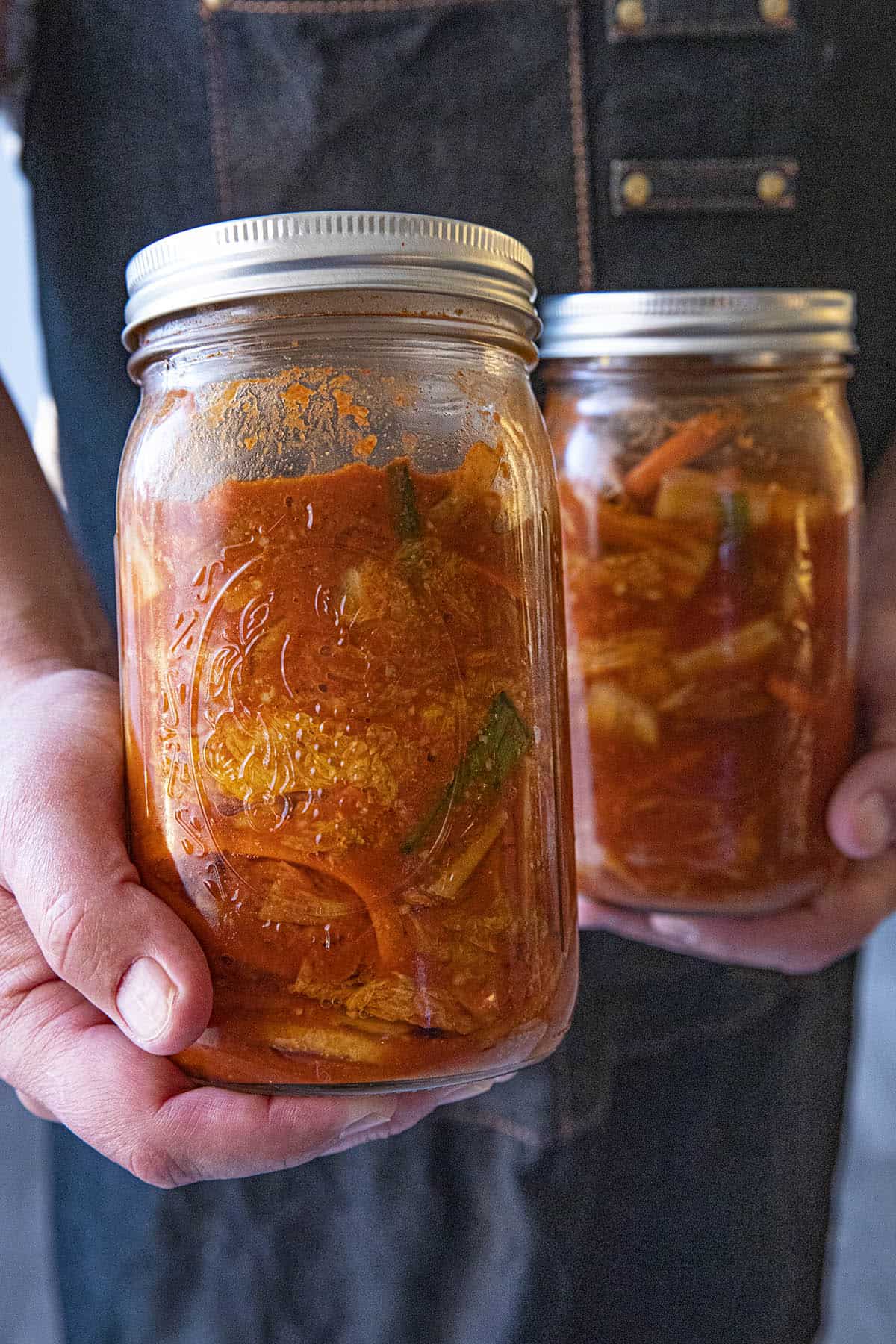
Recipe Tips & Notes
Umami Swaps. More traditional kimchi recipes use salted shrimp (along with fish sauce) to achieve that wonderful umami it is known for, but it can be hard to find.
You can use other ingredients, such as extra fish sauce, shrimp paste, dried shrimp, seaweed, anchovies, dried fish, soy sauce, or miso paste. I enjoy a combo of shrimp paste, fish sauce and miso, all of which I always have on hand for other recipes.
Kimchi Sauce Swaps. Gochugaru is pretty essential, but you can use gochujang instead, which is a Korean fermented chili paste. Try it with both.
Fermentation Times. Fermentation times can vary, depending on temperatures and ingredients. You can ferment longer if you'd like, but it is best to judge by smell and flavor.
The kimchi will grow more sour as it ferments, which some people prefer. Smell and taste after a day or two, then transfer to the refrigerator where it will continue the fermentation process more slowly.
Go Beyond Cabbage Kimchi. Napa cabbage is more commonly used to make kimchi, and is what most people associate with it. However, you can make kimchi with any vegetable, such as cucumber kimchi, which is another popular version, radish kimchi or mustard greens and others.
Try it with some of your favorite vegetables, or a combination of them.
What to Make with Kimchi? Kimchi Recipes
You can simply serve a 1/4 cup to a 1/2 cup as a simple side dish vegetable or snack. Or, swirl it into soups and stews, particularly stir fries where it really shines.
You can also make many dishes with spicy kimchi. Kimchi Fried Rice is hugely popular, and quite delicious, as is Kimchi Stew (kimchi jjigae), and I love to eat Kimchi Ramen.
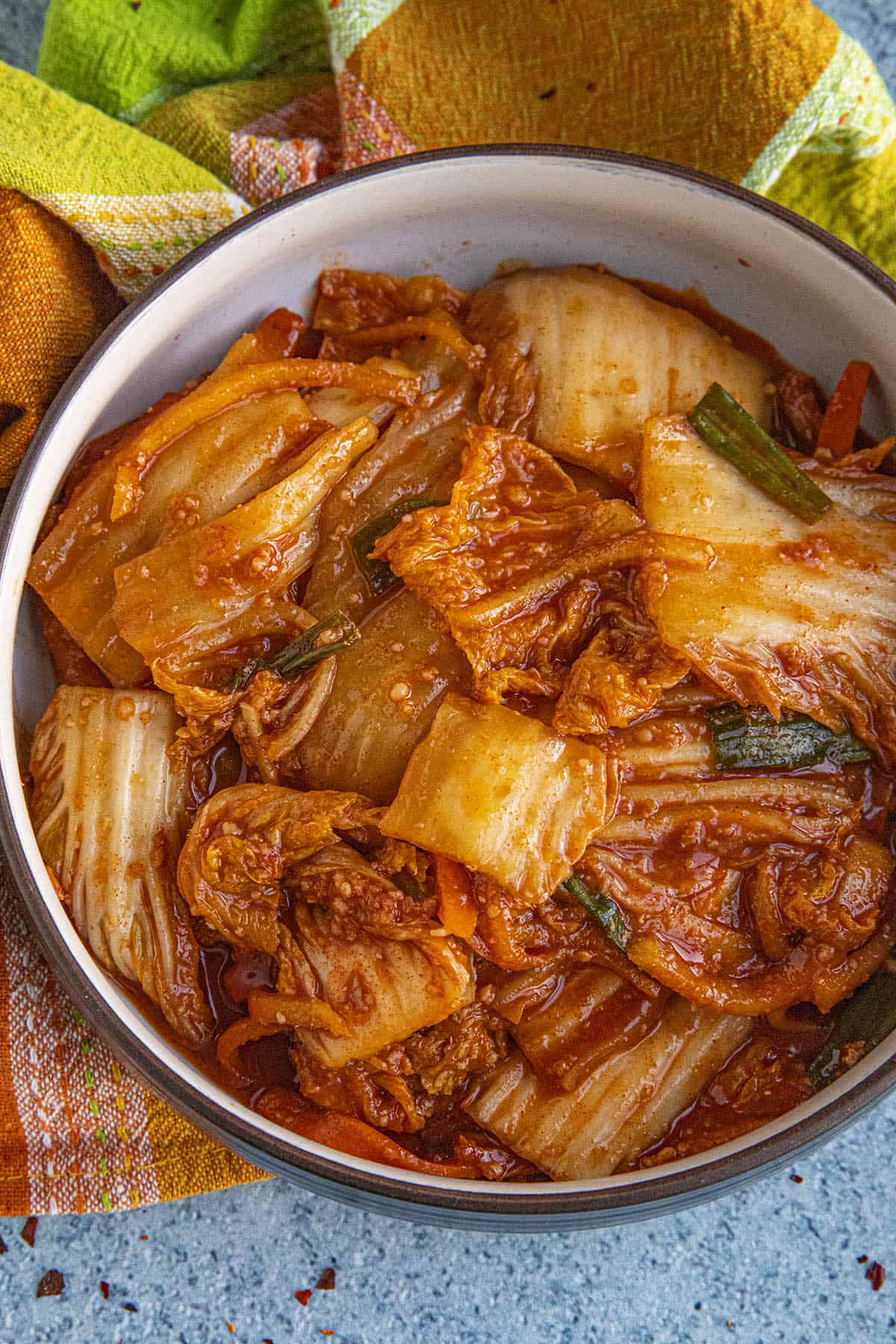
Storage Information
Homemade kimchi will last 6-8 months or longer in the refrigerator in a sealed container. You can use it in so many dishes.
It typically will last 1 week or so outside of the refrigerator, so it is best to keep it refrigerated.
That's it, my friends. I hope you enjoy my kimchi recipe. Let me know if you make it. I'd love to hear how it turned out for you. Keep it spicy! Extra spicy for me, please! I love kimchi.
Try Some of My Other Popular Recipes
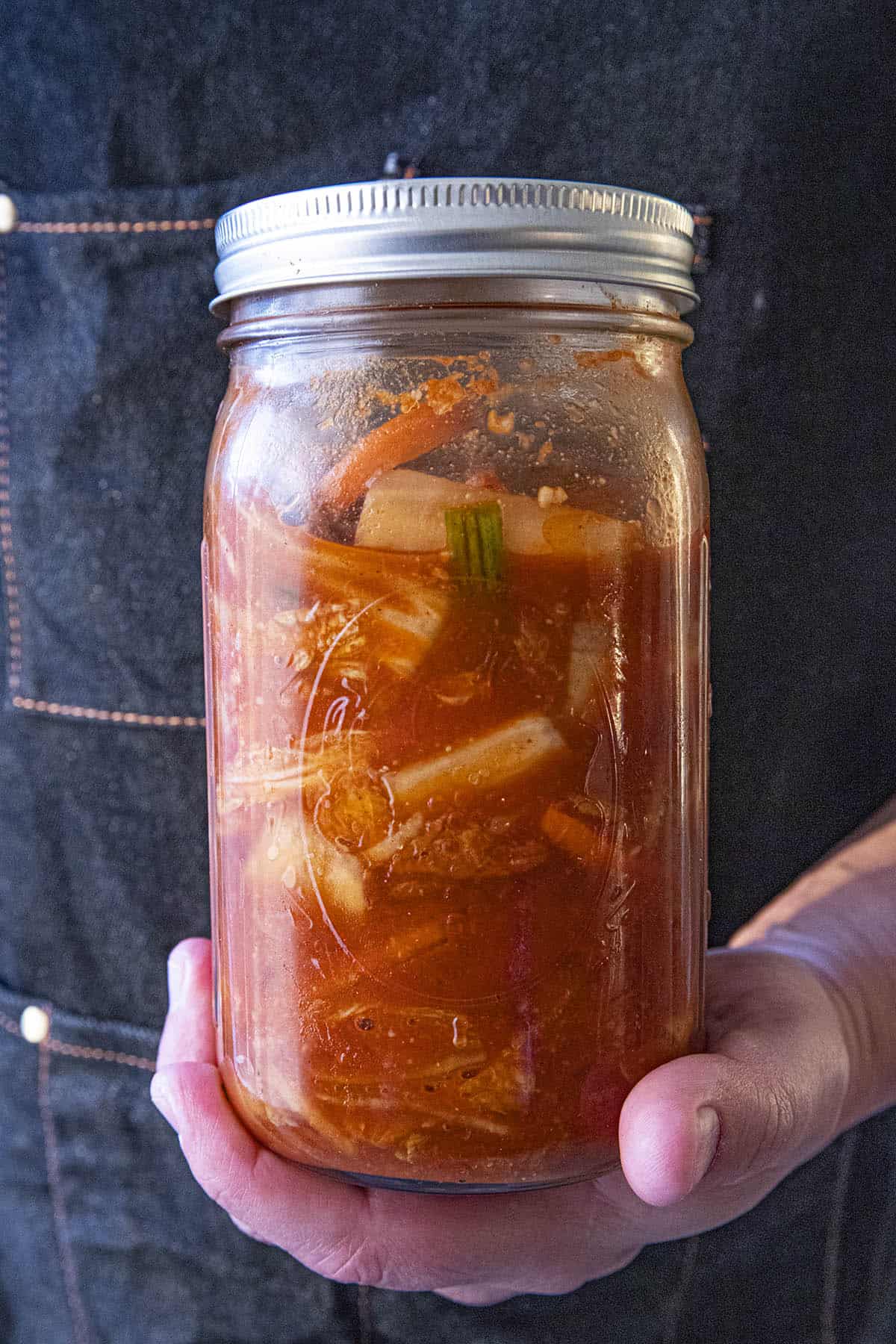
Got any questions? Ask away! I’m happy to help. If you enjoy this recipe, I hope you’ll leave a comment with some STARS. Also, please share it on social media. Don’t forget to tag us at #ChiliPepperMadness. I’ll be sure to share! Thanks! — Mike H.

Spicy Kimchi Recipe (How to Make Kimchi)
Ingredients
FOR THE CABBAGE BRINE
- 2 quarts unchlorinated water filtered or bottled water are good
- ½ cup kosher salt or sea salt
- 1 head about 3 pounds; 1.3kg Napa cabbage
TO MAKE THE KIMCHI
- 1 carrot sliced into matchsticks
- 1 bunch scallions end trimmed, cut into ½ inch pieces
- 1 small daikon radish or turnip peeled, sliced into matchsticks
- ½ Asian pear peeled, sliced into matchsticks
- 6 garlic cloves chopped
- 2 tablespoons fresh grated ginger
- 3 tablespoons glutinous rice flour
- 1 cup gochugaru Korean chili flakes
- 1/2 cup fish sauce
- 3 tablespoons salted shrimp saeujeot, minced – as an alternative, use 1.5 tablespoons shrimp paste, or 3 tablespoons chopped dried shrimp (soaked), or 2 tablespoons miso paste
- 2 tablespoons miso paste red or white – optional, for extra umami flavor
Instructions
BRINE THE CABBAGE
- Whisk together the unchlorinated cold water and sprinkle salt in a large bowl.
- Slice off the root end of the cabbage. Slice the cabbage into quarters and submerge them in the brine. Use a plate or other small weights to keep the cabbage completely submerged.
- Set aside for 8-12 hours at room temperature.
- Set the cabbage into a colander and drain the brine. Rinse the cabbage and squeeze out excess water using your hands. Chop the cabbage into 1 inch pieces (if desired, or leave the pieces whole).
MAKE THE KIMCHI
- Add the cabbage to a large bowl along with the carrot, scallions, radish or turnip, Asian pear, garlic and ginger. Toss to combine.
- Add the rice flour and 1 cup water to a sauce pan. Heat to a simmer, then whisk for 3-4 minutes until smooth and the mixture forms a smooth, loose paste.
- Remove from heat and stir in the gochugaru. The chili flakes will bloom as the mixture cools.
- Stir in the fish sauce, salted shrimp, and miso paste (or your other umami alternatives).
- Pour the mixture into the cabbage and vegetables. With your hands, rub the gochugaru mixture into the vegetables, covering them as completely as possible. Be thorough. Really get in there with your hands!
- Taste and adjust for salt or any other desired seasonings.
- Pack the kimchi into a large mason jar (or several). You can use other vessels, like a fermentation crock. Press the contents down and weigh it down with glass fermentation weights (or use a plastic bag filled with water).
- Cover with a fermentation airlock lid, or use fermentation membranes (see notes). If you don’t have such lid options, use a 2-piece lid, but don’t screw it down, just set it on top. This is to allow any gases to escape while fermenting.
- Set aside away from any sunlit areas and ferment for 1-3 days at room temperature (you CAN ferment longer if you’d like – see RECIPE NOTES on fermentation times). Moisture should release from the kimchi, so press the kimchi down if needed to keep it below the liquid. Gases should escape via the fermentation membrane, or just loosen the lid to let any gas build up out.
- Set into the refrigerator and let sit for 1 week to let the flavors mingle. You can enjoy it right away, but it is better to wait. The fermenting kimchi will continue to ferment slowly in the fridge.
- Use as desired.
Notes
Nutrition Information
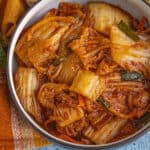
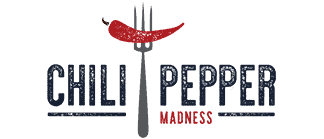

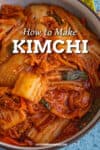
Jessica Jung says
So glad I found this recipe! Its hard to find wet brine, but I think its so much easier! Last time I used this (and Maangchi's recipe) and it came out fantastic! I multiplied it by 5 because I love Kimchi! I eat it plain or with rice, sometimes make Kimchi Jigae with it! This time I'm only using 10 pounds Napa, but I love adding a ton of extra onions and Shallots. The Pear makes it so much more yummy than sugar in my opinion.
Mike H. says
Love how you’ve customized it, Jessica! Adding extra onions, shallots, and pear for sweetness sounds delicious. =)
Elly says
Can I use power Korean chili, instead of flake?
Mike H. says
Yes, you can, but it might create a slightly different texture and spiciness level. Experiment to find the balance you like!
Buffy Chester says
Well I haven't tried your recipe yet but I want to because I can't find the brand that I used to love in the stores anymore! It's just totally gone! So mad! But I grew up on this stuff and loved it, sometimes I would just have it as a snack by itself, like you mentioned. But also, I came up with an unusual way to eat it that you didn't mention. I used to love making a sandwich with it, I would get rye bread and mayo and tomatoes and spicy kimchi and it was sooo good together!!! mmmmmmm!!!!!
Mike Hultquist says
Glad to help, Buffy. I'll have to try that sandwich! Nice!
jill says
just started to research making kimchi and your site with all the "real life" thoughts and instructions, plus the useful substitutions info re gochugaru is so helpful....thanks a huge heap....
Mike Hultquist says
Thanks, Jill! Enjoy!!
JENNIFER VARGAS says
I cant wait to make it it will be my first time. But, I have a question. what size container did you use to store the kimchi? I want to get one that big enough to fit all of it in and take from the container as i go.
Mike Hultquist says
Thanks, Jennifer! I used a couple large quart Ball Jars, so you'll need a single larger container if you're making a big batch. Enjoy!
Alycia Nash says
my fiance and I are currently making kimchi. I have gochujang paste, should I still add miso paste as well?
Mike H. says
Adding both gochujang paste and miso paste might be a bit redundant in terms of flavor and complexity. Both pastes contribute to the umami-rich base of the kimchi, so using one or the other should suffice.
joe says
What might be substituted for rice flour?
Mike H. says
Joe, you could try all-purpose flour, cornstarch or even arrowroot powder.
Joe says
Do you leave the fermentation lid on when it goes in the fridge? or change it to a regular lid
Mike Hultquist says
Either is fine, Joe.
Loretta says
Can I use sardines in water as an umami flavor?
Mike Hultquist says
Yes, you can give that a go, Loretta, though I've never tried it. Let me know how it turns out for you! Enjoy.